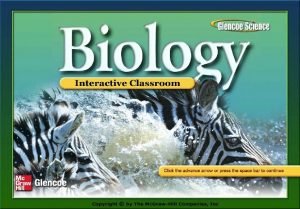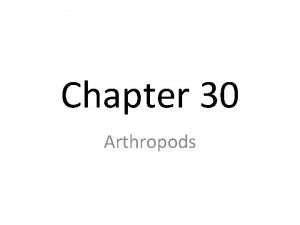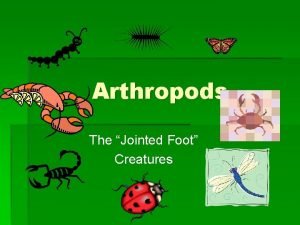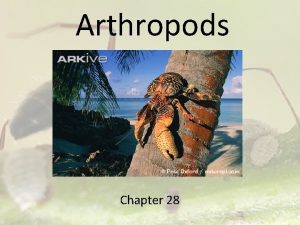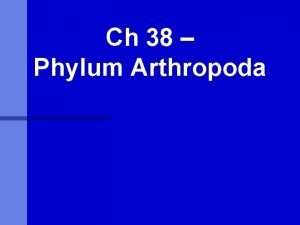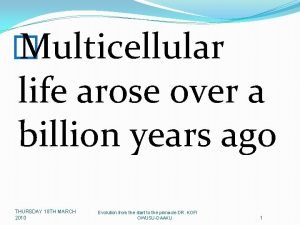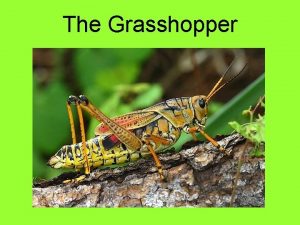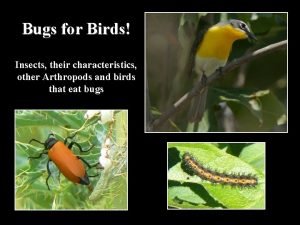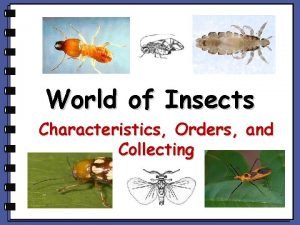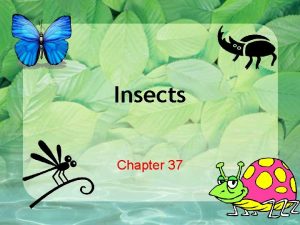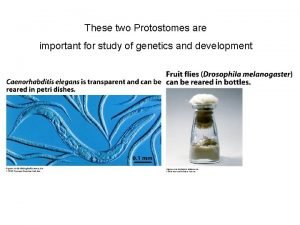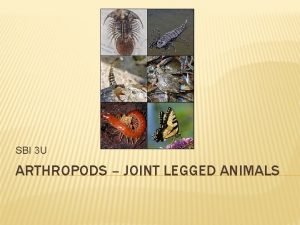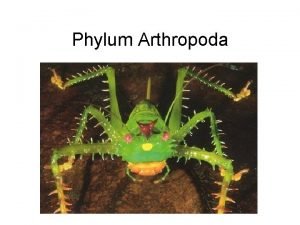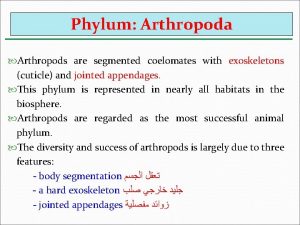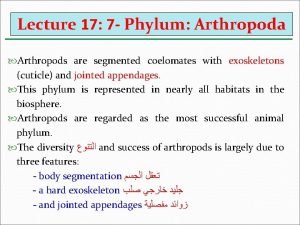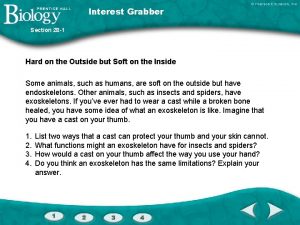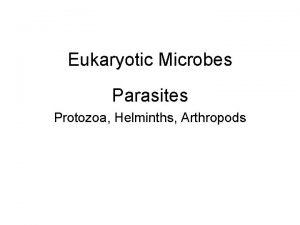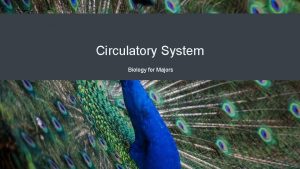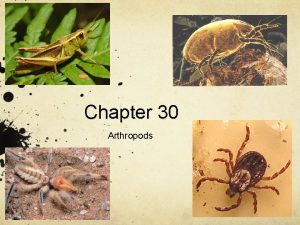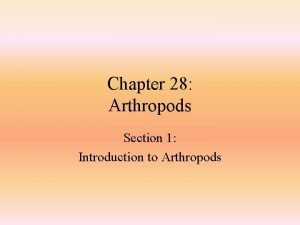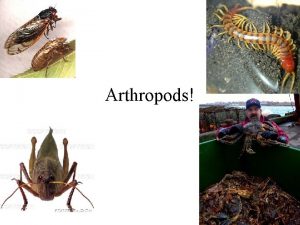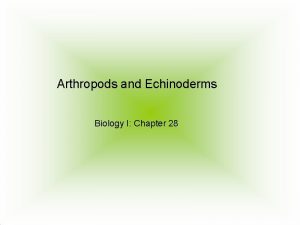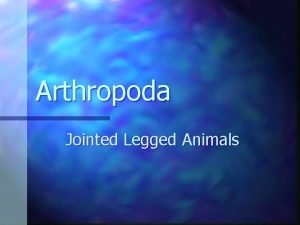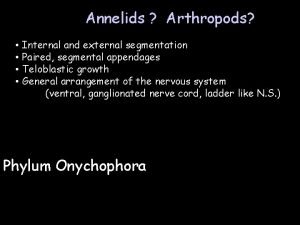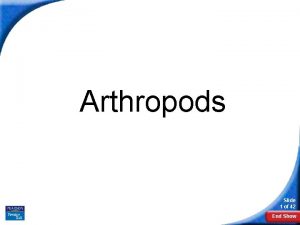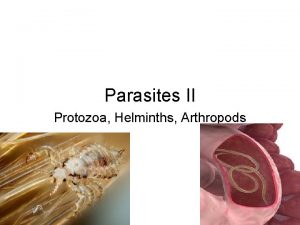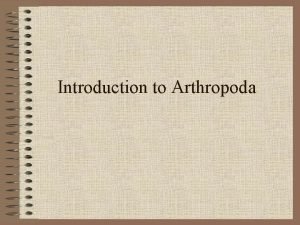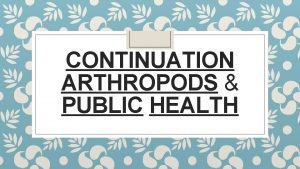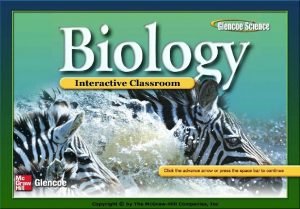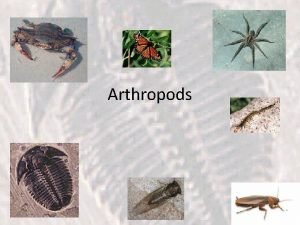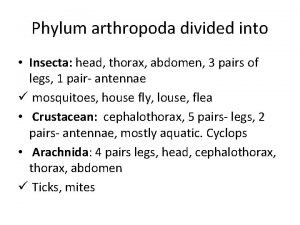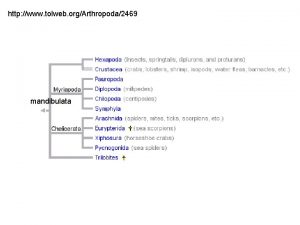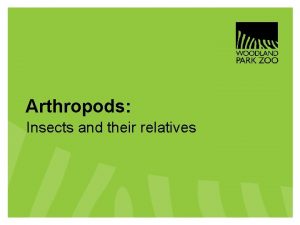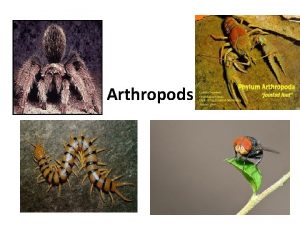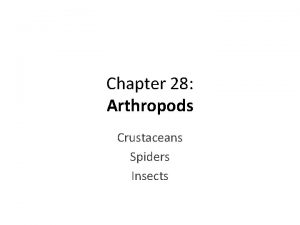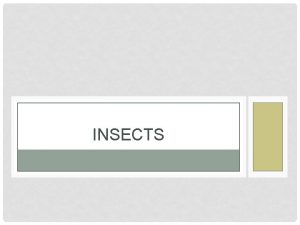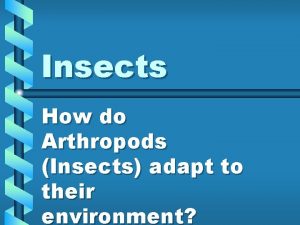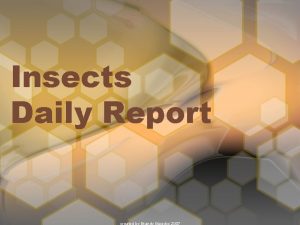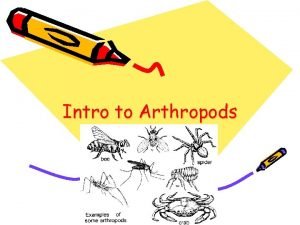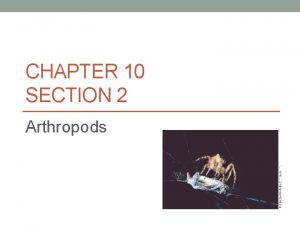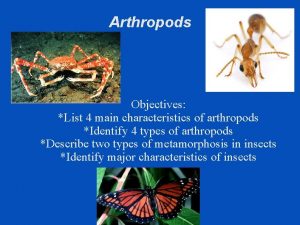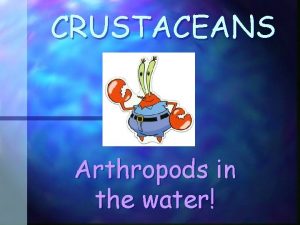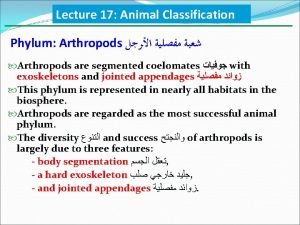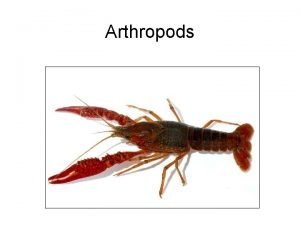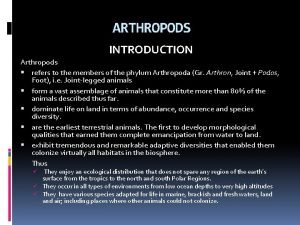Arthropods General Characteristics Day 1 General Characteristics Insects




































![To Do’s • Chart [left] • Questions [right] • Pre-lab (grasshopper or crayfish) To Do’s • Chart [left] • Questions [right] • Pre-lab (grasshopper or crayfish)](https://slidetodoc.com/presentation_image_h2/2d82e2a8c78a7787edc151ce8c5273ad/image-37.jpg)
- Slides: 37

Arthropods General Characteristics (Day 1)


General Characteristics • • Insects, spiders, crustaceans “jointed food” – all have jointed appendages Segmented body Exoskeleton

General Characteristics • Open circulation • Compound eyes • Special tubes for excretion, and respiration

Exoskeleton • Made of carbohydrates • Protection, water proofing • Does not grow with animal – must be shed and regrown Blue Crab Molting

Jointed Appendages • Specialized features, may have many different types of appendages on one body • Most have small muscles, for movement

Segmentation • Most adults have fused segments • Head, thorax, abdomen • Some might have fused head, thorax: “cephalothorax”

Respiration • Land: Using spiracles and trachea – holes along the side of the body for gas exchange • Aquatic: Gills/book gills (Video)

Excretion • Solids, others via anus • Cellular Waste: • Malpighian tubules – terrestrial • Diffusion – aquatic • Green gland – aquatic (lobsters etc) • (video)


Internal Transport • Open Circ • One long, narrow heart along abdomen • Pumps blood through arteries into tissues • Tissues empty waste blood into sinuses…eventually all collects back into large cavity…back to heart

Response • • Well developed Brain = pair of ganglia Compound eyes Sense organs (statocycts, chemo receptors, sensory hairs)

Movement • Coordinated nervous and muscle system • Muscles at exoskeleton joints


Reproduction • Separate sexes • Most is internal fertilization • Most lay eggs • Most development has some form of metamorphosis – major change in body form Horseshoe laying eggs Dragonfly metamorphosis



To Do’s • Groups – Questions & Colouring Sheet! • Dictionary • exoskeleton, green gland, tracheal tube, malpighian tubule, metamorphosis

Questions • What are appendages? Why are they important? • Name at least 3 reasons the exoskeleton is important for arthropods • Why do appendages need to be jointed? • What are at least 2 differences between aquatic and terrestrial arthropods? Why do you think there ARE differences?

Arthropods Types & Examples


Uniramia (Class Diplopoda) Uniramia (Class Chilopoda) Crustacea Uniramia (Class Insecta) Cheliceratea (Class Arachnida)

• round, segmented body two pairs of legs per segment also known as myriapods "thousand feet“ • flattened, segmented body one pair of legs per segment also known as myriapods "hundred feet"

• hard, flexible exoskeleton gills branched antennae two body sections - abdomen & celphalothorax mostly aquatic • two body sections - abdomen & cephalothorax no antennae four pairs of legs chelicerae and pedipalps spinnerets

• • hard, flexible exoskelton gills branched antennae abdomen & cehalothorax

• two body section - abdomen, cephalothorax • NO antennae • four pairs of legs

• three body sections one pair of unbranched antennae three pairs of legs mandibles

Arthropods Pictures

Arachnids


Crustaceans



Insect


![To Dos Chart left Questions right Prelab grasshopper or crayfish To Do’s • Chart [left] • Questions [right] • Pre-lab (grasshopper or crayfish)](https://slidetodoc.com/presentation_image_h2/2d82e2a8c78a7787edc151ce8c5273ad/image-37.jpg)
To Do’s • Chart [left] • Questions [right] • Pre-lab (grasshopper or crayfish)
 Day 1 day 2 day 3 day 4
Day 1 day 2 day 3 day 4 Chapter 26 section 3 insects and their relatives
Chapter 26 section 3 insects and their relatives Day 1 day 2 day 817
Day 1 day 2 day 817 Characteristics of arthropods
Characteristics of arthropods Characteristics of arthropods
Characteristics of arthropods Arthropod
Arthropod Arthropoda
Arthropoda Arthropods characteristics
Arthropods characteristics Arthropods characteristics
Arthropods characteristics Grasshopper segmented body
Grasshopper segmented body Characteristics of an insect
Characteristics of an insect Orthoptera characteristics
Orthoptera characteristics Class insecta
Class insecta Are crustaceans protostomes
Are crustaceans protostomes Arthropods are jointed-legged animals. spiders crabs
Arthropods are jointed-legged animals. spiders crabs Tagmata adalah
Tagmata adalah Arthropods structure
Arthropods structure Segmented coelomates
Segmented coelomates Arthropods
Arthropods Section 28-2 groups of arthropods
Section 28-2 groups of arthropods Summary of hygiene
Summary of hygiene Parasitic arthropods
Parasitic arthropods Arthropods circulatory system
Arthropods circulatory system Joint appendages
Joint appendages 28-1 introduction to arthropods answer key
28-1 introduction to arthropods answer key Jointed appendages
Jointed appendages Arthropod
Arthropod Chapter 28 arthropods and echinoderms
Chapter 28 arthropods and echinoderms Arthropods are jointed-legged animals. spiders crabs
Arthropods are jointed-legged animals. spiders crabs Segmented
Segmented Section 28-1 introduction to the arthropods
Section 28-1 introduction to the arthropods Proserkoid
Proserkoid Introduction of arthropods
Introduction of arthropods Introduction of arthropods
Introduction of arthropods Chapter 26 section 1 arthropod characteristics
Chapter 26 section 1 arthropod characteristics Arthropoda common name
Arthropoda common name Arthropods head thorax and abdomen
Arthropods head thorax and abdomen Amblipygi
Amblipygi

